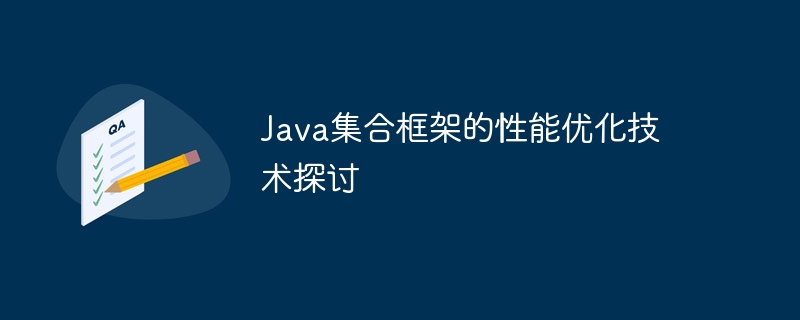Home >Java >javaTutorial >Discussion on performance optimization technology of Java collection framework
Discussion on performance optimization technology of Java collection framework
- 王林Original
- 2024-04-12 14:54:01767browse
Techniques for optimizing the performance of Java collection framework: Choose the appropriate collection type: ArrayList (random access), LinkedList (insertion/deletion), HashSet (search), TreeSet (range query). Capacity planning: Pre-allocate collection capacity to reduce the number of reallocations of memory. Use primitive types: int[] arrays perform better than Integer[] wrapper classes. Avoid object creation: Avoid frequent creation of new objects in loops. Using Java 8 Streams: Parallel processing improves performance on large data sets.

Discussion on Performance Optimization Technology of Java Collection Framework
Introduction
When the application processes a large number of When it comes to data, the performance of the Java Collections Framework is critical. This article explores common techniques used to optimize collection frameworks and provides real-world examples.
Choose the appropriate collection type
Different collection types have different performance characteristics.
- ArrayList: Suitable for random access to large data sets.
- LinkedList: It is more efficient for inserting/deleting elements frequently in the middle of the list.
- HashSet: Used to store unique elements and has the best performance in search operations.
- TreeSet: Stores ordered elements and has the best performance in range queries.
Capacity Planning
Pre-allocating the capacity of a collection reduces the need to reallocate memory with each insertion or deletion.
ArrayList<String> list = new ArrayList<>(1000);
Use primitive types
Basic type arrays have better performance than their corresponding wrapper classes (such as Integer, Double).
int[] numbers = new int[1000];
Avoid object creation
Frequently creating new objects in a loop will cause performance degradation.
// 避免
for (int i = 0; i < list.size(); i++) {
String s = list.get(i).toUpperCase();
}
// 优化
List<String> upperCaseList = new ArrayList<>();
for (String s : list) {
upperCaseList.add(s.toUpperCase());
}Using Java 8 Streams
Java 8 streams provide parallel processing that can improve performance on large data sets.
// 避免
for (String s : list) {
System.out.println(s.toUpperCase());
}
// 优化
list.stream()
.map(String::toUpperCase)
.forEach(System.out::println);Practical case
In an application processing millions of records, the following optimization measures significantly improved performance:
- Use ArrayList instead of LinkedList.
- Pre-allocate list capacity.
- Use primitive type int instead of Integer.
- Leverage Java 8 streams for parallel processing.
These optimizations reduce application processing time from 5 minutes to 30 seconds.
Conclusion
By applying appropriate performance optimization techniques, the efficiency of using the Java Collections Framework can be significantly improved. By carefully selecting collection types, optimizing capacity planning, avoiding object creation, and leveraging Java 8 streams, developers can build efficient and scalable data processing applications.
The above is the detailed content of Discussion on performance optimization technology of Java collection framework. For more information, please follow other related articles on the PHP Chinese website!

